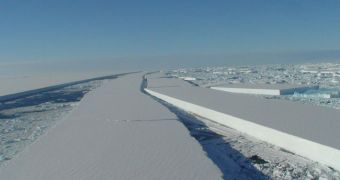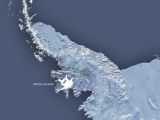Global warming works extremely fast. The next huge chunk of ice which is going to split off Antarctica is now hanging on by a thin strip. First, researchers detected a huge iceberg, 25 mi by 1.5 mi (41 km by 2.5 km), which has broken away from the shelf. But the team at the British Antarctic Survey (BAS) found in fact the entire Wilkins Ice Shelf, about 6,180 square mi (16,000 square km - about half the size of Hawaii) is going to collapse.
"Wilkins is the largest ice shelf on the Antarctic Peninsula yet to be threatened. I didn't expect to see things happen this quickly. The ice shelf is hanging by a thread - we'll know in the next few days and weeks what its fate will be," said David Vaughan of the BAS, who had predicted in 1993 that the northern part of this shelf would be lost within 30 years.
An aerial survey assessed the damage to the ice shelf.
"I've never seen anything like this before - it was awesome. We flew along the main crack and observed the sheer scale of movement from the breakage. Big hefty chunks of ice, the size of small houses, look as though they've been thrown around like rubble - it's like an explosion," said Jim Elliot, who captured video of the phenomenon.
The first iceberg split off from the Wilkins Ice Shelf on Feb. 28. The edge of the ice shelf was found to be disintegrated in a pattern typical of climate-caused ice shelf retreats for all the northern Antarctic Peninsula. By March 8, hundreds of old glacier iceberg had spread across the Southern Ocean over a surface of 540 square mi (1,400 square km), a total loss of over 160 square mi (414 square km) from the ice shelf. Icebergs do not raise the sea levels, as they come from already floating ice shelf.
By mid-March, Wilkins Ice Shelf was kept on place just by a thin strip of shelf ice between Charcot and Latady islands. The Wilkins Ice Shelf started to lose ice in the 1990s. In 1998, the Ice Shelf had lost 390 square mi (1,000 square km).
The Antarctic Peninsula has underwent the highest warming in the Southern Hemisphere in the past 50 years, by nearly 3 Celsius degrees (much more than the global average value and matched only in Alaska), and general ice shelves decreases. Six ice shelves have collapsed, being totally lost: Prince Gustav Channel, Larsen Inlet, Larsen A, Larsen B, Wordie, Muller and the Jones Ice Shelf.
Unlike Arctic ice, which is primarily sea ice, some of which stands year-round and some of which undergoes annual melting/freezing, Antarctic ice is made of ice sheets, layers up to 2.5 mi (4 km) thick placed on the continental bedrock and fueling the floating coastal ice shelves.

 14 DAY TRIAL //
14 DAY TRIAL // 
